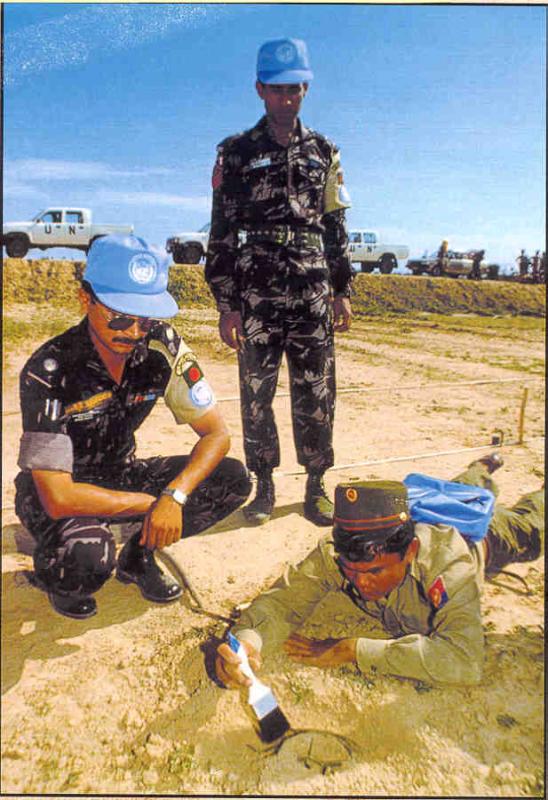When Will We Ever Learn?
By Dr. Chris Giannou

It’s hard to believe, but women and children are still being torn apart everyday by those evil weapons called landmines. Protest from ordinary human beings like you and me have shamed most governments into signing the agreement against landmines. However some have not signed yet and Dr. Chris Giannou shares with us here a little bit of his worldwide experience in treating the shattered bodies of mine victims.
What Mines Do
After 17 years as war surgeon, I know that war wounds are particularly ugly. But there is something specifically horrific and barbaric about mine injuries, so that even after everything I have seen I am still appalled by them. I don’t think anybody can be hardened enough not to be affected when they see what mines do to a human being.
Not to Help but Get Help
By far the largest use of mines is in rural areas where at the best of times there is a problem of communication and of transport. In a semi-nomadic society like Somalia, water holes (which are important to the survival of people and their flocks) have often been mined. It may take up to two weeks for someone who is injured to reach a hospital which could be hundred of kilometers away. A major problem in rural areas is that, if the injured person is accompanied, the immediate reflex of their friend is to rush and help them, thus entering a minefield. Then you are talking about two injured people and nobody to go get help. People have to overcome this natural urge to rush in. They have to fetch help, get the person removed from the minefield, staunch the bleeding, provide basic first-aid which may not always be available and transport the victim to the nearest health facility. In areas such as Angola, Mozambique and Somalia you are talking here hundreds of kilometers.
Complex and Costly Surgery
In purely medical terms mine victims require more antibiotics and dressings and longer hospital stays. People who have to suffer an amputation will need seven times a much blood, on average, as those wounded by gunshot. If 10 percent of patients in a hospital have been wounded by mines, they may constitute 80 percent of the supplies. It is difficult, time-consuming surgery. I’ve been in situations where I’ve worked for 20 hours a day for weeks on end in the threatre.
Nature’s Fault?
 They are also indiscriminate in terms of the times and place. In 1992 I was working in Beled Weyne in Somalia and I had to operate on a young girl. She used to go down to the riverside everyday to fetch water from a place in the centre of the town. One day she went to the same place and stepped on a mine. In 1977 Ethiopia and Somalia had been at war and troops had mined the mountains along the borders. Fifteen years later the rains had carried this small plastic water resistant mine down the hillside, along the river, 40 kilometers further downstream where it came ashore and the young girl stepped on it. The military may say, “We make maps f our minefields and we provide notification and markings,” but the rains fall and the winds will blow and snow will melt and soil will erode. And mines will displaced ending up years later, in places far from the minefields. Nature does not respect national boundaries.
They are also indiscriminate in terms of the times and place. In 1992 I was working in Beled Weyne in Somalia and I had to operate on a young girl. She used to go down to the riverside everyday to fetch water from a place in the centre of the town. One day she went to the same place and stepped on a mine. In 1977 Ethiopia and Somalia had been at war and troops had mined the mountains along the borders. Fifteen years later the rains had carried this small plastic water resistant mine down the hillside, along the river, 40 kilometers further downstream where it came ashore and the young girl stepped on it. The military may say, “We make maps f our minefields and we provide notification and markings,” but the rains fall and the winds will blow and snow will melt and soil will erode. And mines will displaced ending up years later, in places far from the minefields. Nature does not respect national boundaries.
Denying Deadly Reality
The international community no longer accepts that you use exploding bullets against soldiers, it does not accept that you gas soldiers; it does not accept that your infect soldiers as a means of warfare. Yet we continue to tear people’s limbs off. It seems to me that that’s just as terrible as infecting or grassing someone.
Landmines are completely indiscriminate in terms of the victim -a soldier places a mine in the fields and doesn’t know whether a friendly soldier, an enemy soldier woman, child or peasant is going to step on the mine.
